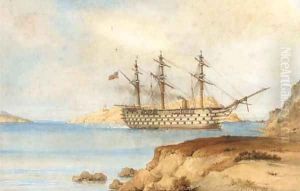Sir Oswald Walters Brierly Paintings
Sir Oswald Walters Brierly was an English marine painter, who became one of the most prominent maritime artists of the 19th century. Born on May 19, 1817, in Chester, England, Brierly was initially educated as a naval architect, a discipline that profoundly influenced his later work as an artist. His fascination with the sea and ships guided his career path toward marine painting, capturing the dynamic and powerful essence of the ocean and naval life.
Brierly's early career was marked by his adventurous spirit. In 1839, he embarked on a voyage to Australia aboard the whaling ship Wanderer, which provided him with an abundance of inspiration for his future works. This experience was pivotal, as it allowed him to observe and document the sea and its vessels firsthand. His drawings and paintings from this period are notable for their detail and accuracy, reflecting his keen observation skills and deep appreciation for maritime subjects.
After returning to England, Brierly's reputation as a marine artist grew. He was particularly known for his involvement with the Royal Navy, accompanying naval expeditions as a war artist. His work during these voyages captured significant naval battles and expeditions of the time, making him a valuable asset for documenting British naval history. Queen Victoria, recognizing his talent and contribution, appointed him Marine Painter to Her Majesty, an honor that further solidified his status as a leading marine artist.
Throughout his career, Brierly exhibited at prestigious venues such as the Royal Academy and the British Institution. His works were celebrated for their technical accuracy, attention to detail, and the ability to convey the majesty and peril of the sea. In addition to his paintings, Brierly also produced a significant amount of sketches and drawings, which were highly regarded for their artistic and historical value.
Sir Oswald Walters Brierly's legacy as a marine artist was cemented by his knighthood in 1885, in recognition of his contributions to art and the documentation of British naval history. He continued to paint and exhibit his work until his death on December 14, 1894, in London. Today, Brierly's works are held in high esteem and can be found in various prestigious collections and museums around the world, serving as a testament to his enduring impact on the field of marine art.





